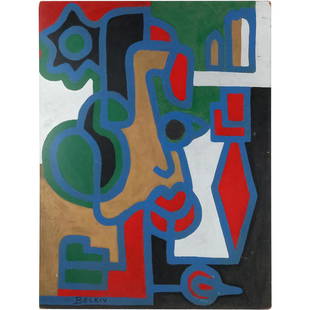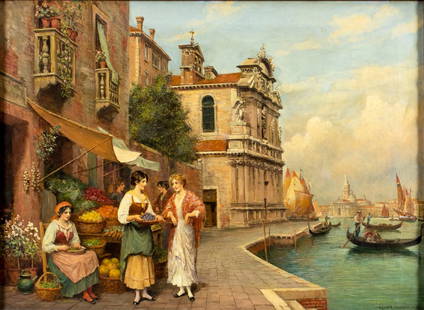
Arnold Belkin (1930 - 1992) New York, Canada, Mexico Abstract Circle in Square Oil Painting
Similar Sale History
View More Items in Paintings
Related Paintings
More Items in Paintings
View MoreRecommended Art
View More





















Item Details
Description
size: 25 x 25, 25.75 x 25.75 outside frame. ASKart: Arnold Belkin has been referred to as "the Canadian son of Mexican muralism". Belkin was born in Calgary, Alberta in 1930 and raised in Vancouver. He began drawing and painting at an early age and completed his initial studies at the Vancouver School of Art. Arnold's father was a left-wing Russian Jew who had quite a prominent name in the Vancouver Jewish community, and his English mother was responsible for instilling a very strong sense of culture in her son.As a young man Arnold Belkin was not drawn to the traditional Canadian style of painting. When he was 14 years old, Belkin discovered Diego Rivera and Mexican Muralism in the pages of "Time Magazine". The magazine showcased a few of Rivera's works, documenting Rivera's commitment to the figure, which made a great impact on Belkin. In Canada, the tradition in fine art is landscape painting, but something in Belkin's temperament did not draw him to this genre. It was not that Arnold rejected landscape painting, it just didn't much interest him.At the age of 15, while a student at the Vancouver School of Art, Arnold Belkin won a competition for his painting, "Workers on a Streetcar". This early work can be considered a preamble to his oeuvre. His art carried seeds of rebellion from a young age, and throughout his life, Belkin maintained an interest in social issues and the rights of the poor and underprivileged classes. This interest, along with his concern regarding the abuse of power by the upper class permeated his artistic output throughout his career.In 1947, after finishing high school, Belkin moved to Mexico to further his study of painting. He was attracted to the political public art of the Great Mexican Muralists - Diego Rivera, José Clemente Orozco and David Alfaro Siqueiros. Upon arrival in Mexico City, Belkin entered la Esmeralda School of Painting and Engraving. As are all residents of Mexico City, Belkin was surrounded by murals that contained bold images of revolution by the poor, dark skinned, oppressed peoples of Mexico. Belkin was very much attracted to the politics of public art that was covering the walls of the city and he soon enrolled as a student and assistant to Siqueiros. Siqueiros taught Belkin invaluable lessons in quality and standards that he maintained throughout his career.In Mexico there was a problem of generations. The older, well-established artists dominated mural production. It was a struggle for young artists to get involved and be recognized in their own right. The first mural project that Belkin received was at a new federal penitentiary. He was not paid for this project, but the warden came up with the money for the materials and this provided a great opportunity for Belkin to get his "foot in the door" as a muralist.Belkin's mural at the prison was titled, "Somos todos cupables" (We Are All Guilty). It is the story of a law-breaker who is caught and tried, jailed and eventually freed. Belkin seemed to approach this project not just as a painter but also as a social worker and journalist. He read "Crime and Punishment", attended prison chapel and engaged some of the inmates as assistants during the production of the mural.Soon the mural projects were lining up. Belkin painted "Identity and Future" at Colegio Madrid in Mexico City. "Identity and Future" covers the walls of the school's staircase. The imagery is part history, part morality and part reflection on the artist's concerns. Belkin is also responsible for one of the largest murals that was ever completed in Mexico City, "Jewish Festival", done at the Jewish Center in Mexico City. By the early 1960s, Arnold Belkin had established himself as the angry young man of mural painting. He believed history was a mirror of the future and his imagery reflected this belief. It is surprising that this Canadian understood with such clarity, the mechanisms of happenings in Latin America.A mural that some consider one of Belkin's best compositions was completed at the Child Welfare Centre in Mexico City. Entitled "A nuestra generación corresponde decidir" (It Rests with Our Generation to Decide) the work was whitewashed soon after it was finished. The mural was destroyed because the wife of then Mexican president (also the honorary head of the Centre) thought it was too sad. Belkin protested the removal of this mural but to no avail. The destruction of murals was nothing new and several artists before Belkin, including Diego Rivera and David Alfaro Siqueiros, had faced the same devastation. Like Rivera, Arnold Belkin decided to seek inspiration abroad. In 1968 Belkin went to live and work in New York City.While in New York, Arnold Belkin was asked to do a mural as part of a larger effort to rebuild a playground in Hell's Kitchen (at 45th and 46th Streets). The wall assigned to Belkin by the architect was close to 40,000 square feet. A huge project by any standard, Belkin enlisted anyone who was willing to take instruction. This resulted in the young people of the community being very proud of the finished product, which is titled "Against Domestic Colonialism". Whereas, graffiti plagues the streets of New York, this mural has passed the years relatively unscathed. "Against Domestic Colonialism", like Somos todos cupables at the federal penitentiary in Mexico, was groundbreaking in that it simultaneously expressed community politics and community participation.Belkin's easel paintings also enjoyed much success during his time in New York. His paintings sold well at the galleries and increasingly addressed controversial political themes such as: the "My Lai Massacre in Vietnam", the killings at Kent State, the assassination of Che Guevara, and the military coup in Chile. In 1974, Belkin embarked on project of paraphrasing compositions by masters from the history of art. Interpreted works include Jacques-Louis David's "Death of Marat "and Nicolas Poussin's "The Rape of the Sabines". In regards to this project, Belkin stated, "My subject in these great battles is the violence of the armed military men against defenseless people, an occurrence that is not unusual in the history of humanity, that nevertheless is horrifying and astonishing every time it happens."Belkin's artistic output was consumed with images and ideas of the future and utopia. Some of his paintings, like "Armoured Figure", which was completed during Belkin's tenure in New York, feature metallic, robotic and fragmented figures. Such compositions are Belkin's warning against war and technology enslaving the human spirit. Throughout his life, Belkin was committed to presenting humanity's most controversial and sometimes painful experiences. He was never interested in producing murals or easel works that could be considered mere diversion.In spite of his successes in New York City, Arnold Belkin wanted to be a part of Mexican history and culture. He returned to Mexico in 1976 and became a citizen there in 1981. Belkin's career spanned more than three decades, during which time he produced 28 major public murals, staged 50 exhibitions of his easel works, designed sets and costumes for 40 Mexican stage productions, wrote for newspapers and taught fine art at universities. Arnold Belkin died in Mexico City in 1992 of lung cancer, perhaps caused by years of using acrylic paints with an airbrush.During and following Belkin's life he was treated as a celebrity in art circles throughout Mexico and much of Latin America. This leftist Jew who left Vancouver to become one of Mexico's greatest painters, played a fundamental role in the history of painting in Mexico. Some art critics insist that Belkin's international reputation exceeds that of any other individual Canadian painter.
Condition
It is the Buyer's responsibility to inspect each lot and deem their own opinions on condition, description, provenance, and validity BEFORE purchasing.
Please email us at donny@donnymaloneauctions.com with any questions so we may aid you in your assessment.
All descriptions are visual opinions based on the Auction house's experience and do not warrant as a guarantee.
Condition is appropriate to age of the item. The absence of a condition report does not imply that the lot is free from damage and wear.
Please review all pictures posted on this listing. We encourage all buyers to request a condition report and/or additional photos prior to bidding on any lot as ALL ITEMS ARE SOLD AS-IS, WHERE IS.
Bidding:
- All items are sold as-is where-is meaning there are no guarantees or warranties whatsoever. Bidders agree to complete their own due diligence and take full responsibility in all of their purchases.
- Buyers premium of 25% on all items. (An additional 25% is added to the hammer price of your winning bid, called the buyers premium.)
Payment:
-Invoices are sent via Email after the auction , please check spam and junk folders.
-Invoices over $3,000 USD will need to be paid with either a wire transfer or certified bank check.
-Invoices under $3,000 USD can be paid by paypal, visa, mastercard, discover, check, wire, money order, cash.
-Disputes for non paid items are issued 1 week (7days) after the auction date.
Pick-up & Shipment :
-Buyers are required to pick up their purchased property within 2 weeks of the auction.
-The auction does not and will not ship any items.
-Our primary and preferred shipper Gravity Boxes will automatically send all non-local paid invoices a courtesy shipping quote within 12-48 hours after payment, via email.
-Buyers are responsible for negotiating and scheduling their own shippers for their items.
-The auction house works closely with about 8+ private shipping companies that will be listed on your invoice.
Storage & Item Neglect:
-Buyers who have hired any of the listed shipping companies on the invoices within the 2 week time period will be exempt from storage fees.
-Items that are not picked up or paid to be shipped within 2 weeks (14 days) of the auction are subject to storage fees. Storage will be 5 dollars per day , per lot item.
-Items that are not paid for storage or shipped within 30 days of the auction will be considered neglected and abandoned.
-Neglected items will be forfeited from the buyer without refund.
For the full Terms and Conditions please “Auction Policies?? on any item listing.
Buyer's Premium
- 25%
Arnold Belkin (1930 - 1992) New York, Canada, Mexico Abstract Circle in Square Oil Painting
Shipping & Pickup Options
Item located in Saugerties, NY, usPayment















































































